Pin Nailer vs. Brad Nailer: Which is Better for You?
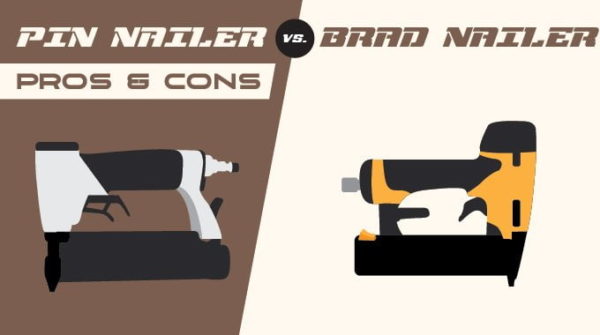
For most woodworkers and DIYers finishing always requires more of attention and effort. And this is because everybody wants to give their projects the best finish possible for an aesthetically appealing look.
Whether you are doing some renovations, making cabinets or even working on trims, you need a good finish nailer. But in many instances, you will need to pick between the pin and brad nailers.
While it is always a good idea to have both in the workshop, for most woodworkers, you need to buy one first, and some will also just prefer to pick one.
What you pick between the two nailers will depend on the type of projects that you often do. But, knowing the capabilities of each of the two handy nailers will make the decision easy for you.
You can also read other nail gun reviews such as framing nailer, finish nailer, roofing nailer, siding nailer, palm nailer.
Pin Nailer
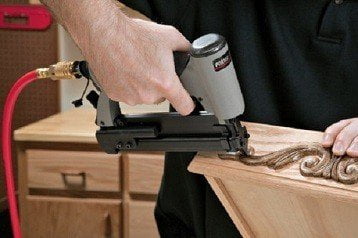
We all hate filling holes after finishing cabinets, coffee tables, and many other woodwork projects. But, filling the nail holes is always necessary to enhance the appeal of the workpiece.
If like many other woodworkers you hate having to fill each nail hole then you need to go for a pin nailer for your finish carpentry.
As the name suggests, this nailer shoots thin headless nails or what many woodworkers refer to as pins. The pins are 23-gauge and will in most cases not leave any visible holes in the workpiece.
Majority of pin nailers will only take pins that are 1-inch long, but it is also possible to get some high-end models that you can use with 2-inch long ones.
Pin nails will offer almost no holding power at all, and so it is necessary to use them with adhesives such as wood glue.
Lack of holding power means that in most cases pin nailers will be best for keeping pieces together while the wood glue dries. The fact that they are also easy to pull out and will drive in even into hardwood also makes them ideal for this application.
There are many projects where the pin nailer will be handy, but overall they are best suited for joining delicate trim pieces, thin veneers and also when working on small furniture trim.
Pros
- No visible nail holes. The 23-gauge headless nails that the pin nailer uses are thin enough to ensure that they do not leave any visible nail holes. If you are planning to apply varnish, stain or paint the workpiece, you will not need to do any filling and this, in turn, saves you both cash and time.
- Will not split wood. The tiny size of the pin nails also has the advantages of not splitting the workpiece. Although the brad nail will not break the wood when working with regular size pieces the same is not true if you use it on small furniture trim. But, with a pin nailer, you will never have to worry about splitting the workpiece.
- Best for delicate trim pieces. The 23-gauge nails will be ideal when working with delicate trim pieces that tend to split easily. These thin pin will hardly split any workpiece no matter how small and fragile it might be and so this nailer is always the best choice when working on thin veneers and installing tiny trim on furniture.
Cons
- Little holding power. With a pin nailer, you will get little to no holding power at all. And what this means is that you cannot rely on the nails alone to hold your pieces together and so you will also need to use wood glue or other adhesives. Also, unlike the brad nails the pin nails are headless and this in turn also reduces the holding power.
- Not very versatile in its applications. There is not much that you can use the pin nailer for around the workshop due to the nature and size of the nails that it shoots and so the chances are that it will be one of those tools that you rarely use.
Brad Nailer
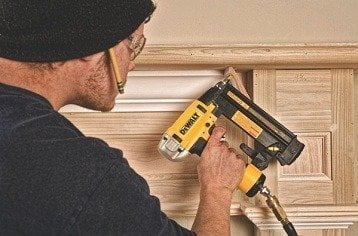
There is always that one tool that you want to have around when doing some finishing carpentry. For most woodworkers (both beginners and professionals) it is the brad nailer as it is as versatile as it can get.
The distinctive flat nail heads on the 18-gauge nails that the brad nailer shoots are its most distinctive features. And woodworkers love the nailer because the fasteners still provide almost as much holding power as the 15 and 16 gauge nailers but without leaving large holes on the workpiece.
You can get the brad nails in a variety of lengths between 3/8 and 2 inches for a variety of applications, and this is one of the things that make this nailer very versatile.
Besides from finish carpentry you can also use the brad nailer for base-boarding the same way you would use the 16-gauge. And this is a task that will be almost impossible to do with a pin nailer.
Overall, the brad nailers are more versatile than the pin nailer, and you can use them for most kinds of trim work, crown molding, and cabinetry finishing.
Pros
- More holding power. The 18-gauge nails that the brad nailer shoots will provide a decent amount of holding power. It might not be as much as you get from the 15-gauge nails and others larger ones but it is way much more than the pin nailer can provide. The fact that you can also use a brad nailer for nailing baseboard should be enough to show that it produces significant holding power.
- Versatile finish nailer for various applications. The brad nailer is one of those power tools that you will use for almost any project. There is always a task that will require you to bring out the brad nailer whether you are doing some home improvement, crown molding or building cabinets. And this is unlike the pin nailer that is only handy when dealing with thin or tiny materials.
- Also good for base-boarding. Most woodworkers will get the brad nailer for their finish carpentry, but it can also be useful for base-boarding. And this is because it can provide almost as much holding power as what you get from using the 15 or 16-gauge nailers.
Cons
- Visible nail holes. Although the holes that the brad nails will leave are not as large as what you get when using the 15 and 16-gauge nailers they are still quite visible. And even if you intend to stain the workpiece or paint it, you will still need to fill the holes to maintain the aesthetic appeal of the project.
- Can split the workpiece. When working with small furniture trim, thin veneers and other delicate and soft materials the brad nail might not be your best choice. The 18-gauge nails and others that are larger than this may end up splitting these precarious woods.
The Bottom Line
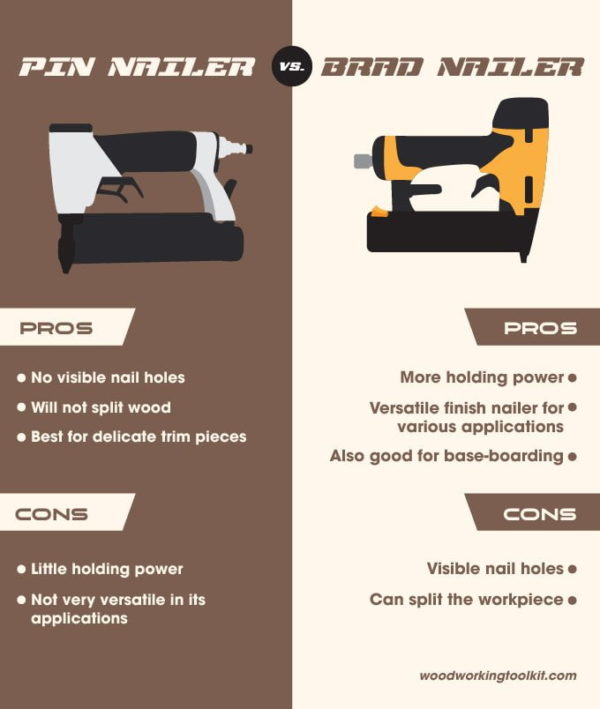
Finish carpentry takes more effort and time for most woodworkers and so it is always vital to have the right tool. And when you have to pick between the pin and brad nailers the wise idea is to go for what you think you will use most.
For many woodworkers and DIYers, the brad nailer is always the best option thanks to the versatility and also the fact that it can be handy for more than just finish carpentry.
Also, the brad nailer provides more holding power, and the chances are that it is one of the tools that you will need most as you might have to use it for almost all your projects.
If you hate having to use wood putty to fill nail holes, deal with delicate trim pieces and thin veneer a lot or just want something to hold your pieces together as glue dries the pin nailer is an excellent choice
But, if you can afford both tools the better and this is because they will be handy for different situations.
Best Pin Nailers
1. Hitachi NP35A 1-3/8 Inches 23-Gauge Pin Nailer
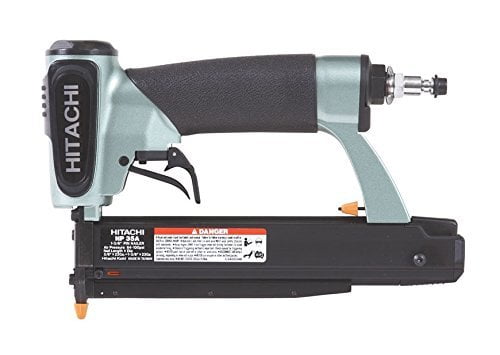
When working on a woodworking project that requires you to use lots of pin nails, it will be better to have a nailer like the Hitachi NP35A as it has a large fastener capacity for fewer reloads.
And besides, from the large capacity, this high performing pin nailer will also feature an automatic magazine adjustment to accommodate different pin lengths for a variety of applications.
The Hitachi NP35A uses a dual trigger system to ensure safety and accuracy when placing the fasteners. And there is also a rare exhaust that will help to direct the debris from the surface you are nailing.
The depth adjustment capability makes it possible to determine how far you want the pins to go depending on the surface while the large housing will help protect the work surface.
Other features that make this an outstanding nailer include the reload indicator that lets you know when you are running out pins and removable nose plate to make it easy to clear jams.
[su_asin asin="B003SHDM84"]
2. Porter-Cable PIN138 23-Gauge 1-3/8-Inch Pin Nailer
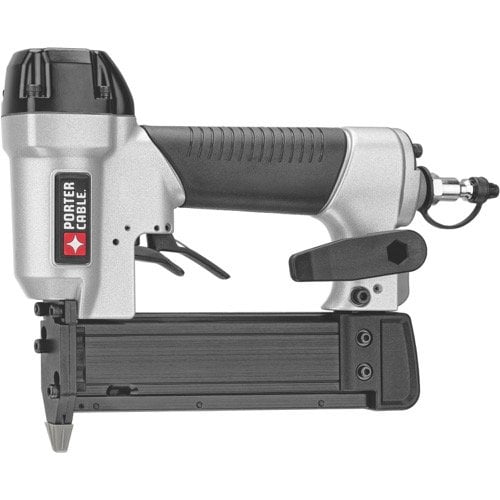
The Porte-Cable PIN1378 is an ideal pin nailer for both beginner and professional woodworkers looking for a reliable finish nailer but without spending a lot of cash.
It can accommodate both headless and slight-head pins with lengths of between 5/8 and 1-3/8 inches to make it quite a versatile pin nailer that will be ideal for a variety of applications.
The powerful and long-lasting motor that drives this power tool makes it reliable and also ensures that it will be long before you need a replacement.
Like most other high-quality pin nailers this one will adjust automatically to accommodate different pin lengths for quick and easy loading.
And besides, from the pin nailer, you will also get 2000 pins, a wrench and carry case on your purchase to ensure that you have everything you need to use the tool straight from the box.
[su_asin asin="B0049ZBOUM"]
Best Brad Nailers
1. Hitachi NT50AE2 Brad Nailer
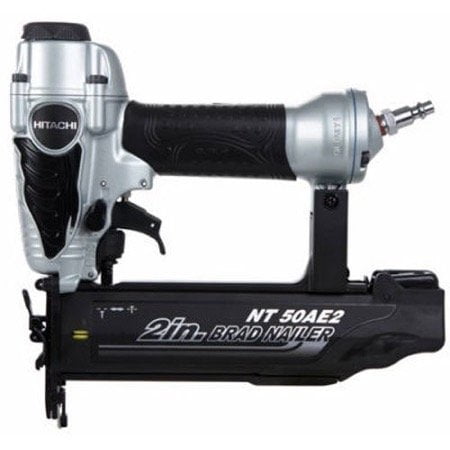
The affordable Hitachi NT50AE2 brad nailer allows for both intermittent and continuous firing to make it a suitable tool for a variety of applications.
It also features a convenient depth-of-drive adjustment knob that will make it easy and quick to vary the driving depth without having to use any tools.
The manufacturer also makes this finish nailer with both comfort and ease of use in mind. It weighs 2.2 pounds only, and it is also well-balanced to make it comfortable for extended use, and it also has an elastomer grip that is comfortable on the hand and also prevents slippage.
With this brad nailer, you will also never have to worry about clearing jams because the design of the nose makes it easy and you will also not have to use any tools.
[su_asin asin="B000H399PC"]
2. Bostitch BTFP12233 Smart Point 18GA Brad Nailer Kit
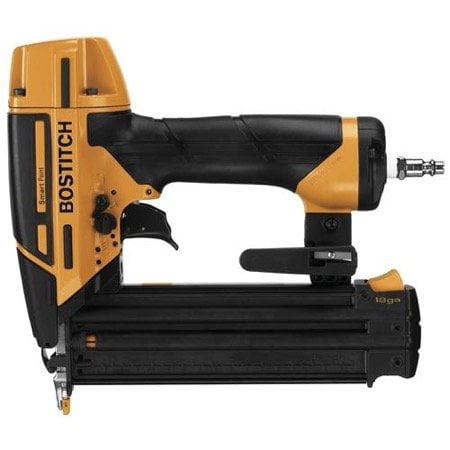
Brad nailers are one of the tools that you will end up using a lot, and so you need something convenient that can withstand the pressure such as the Bostitch BTFP12233.
This nailer uses a smart technology that entails giving it a small nose to make nail placement easy and without having to actuate the tool by compressing the contact trip.
The oil-free operation of this brad nailer reduces the risk of staining the workpiece, and it also features tool-free jam release and dial-a-depth control.
There is also a rear exhaust on the nailer to keep contaminates away from the woodworker's face and work surface. Other features include an adjustable belt hook to make carrying easy and an integrated sharpener for your pencils.
[su_asin asin="B00JTYO248"]
Last Updated on January 18, 2019 by
